Principles of Auditing : Assignment
VerifiedAdded on 2021/06/14
|13
|2781
|61
AI Summary
Contribute Materials
Your contribution can guide someone’s learning journey. Share your
documents today.
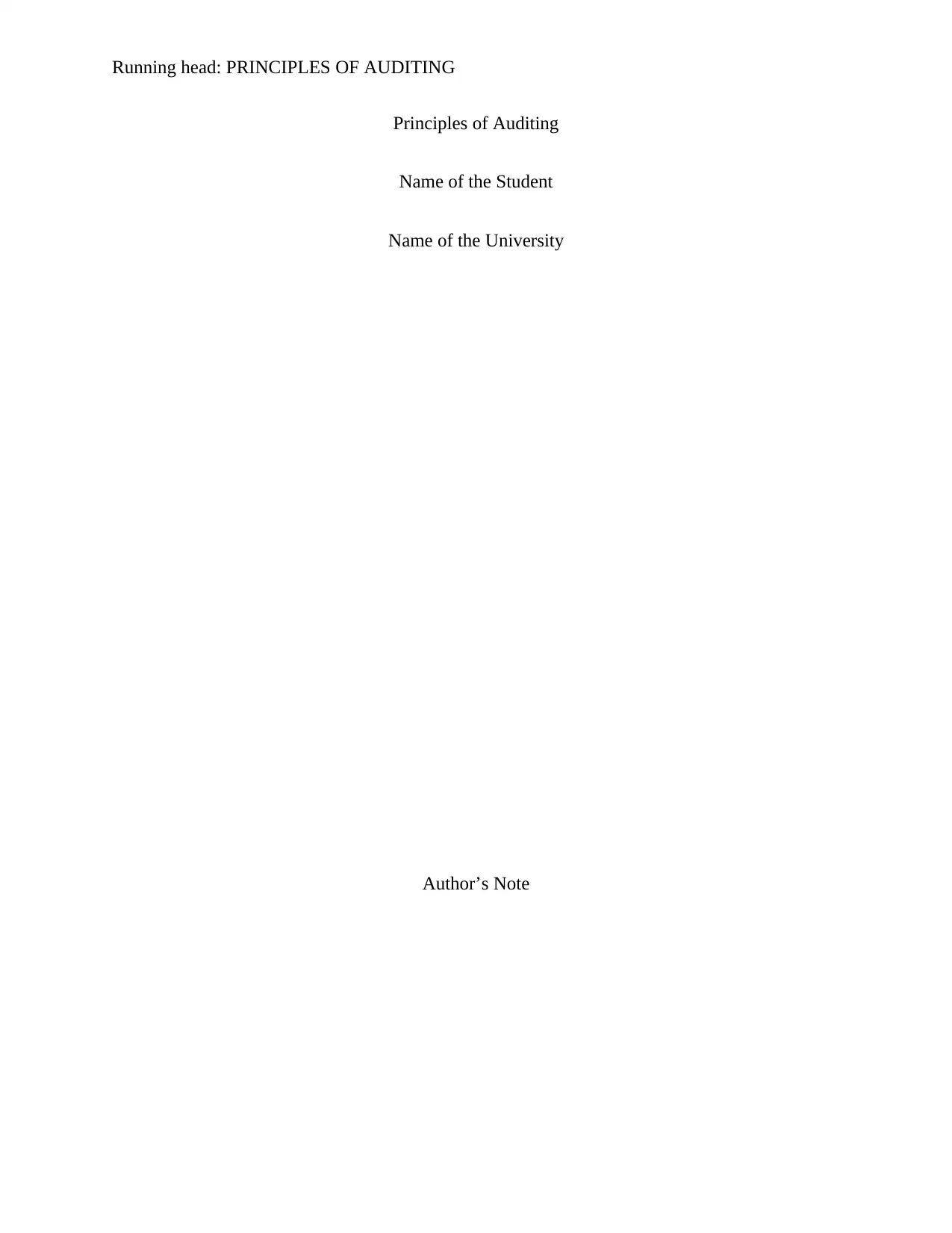
Running head: PRINCIPLES OF AUDITING
Principles of Auditing
Name of the Student
Name of the University
Author’s Note
Principles of Auditing
Name of the Student
Name of the University
Author’s Note
Secure Best Marks with AI Grader
Need help grading? Try our AI Grader for instant feedback on your assignments.
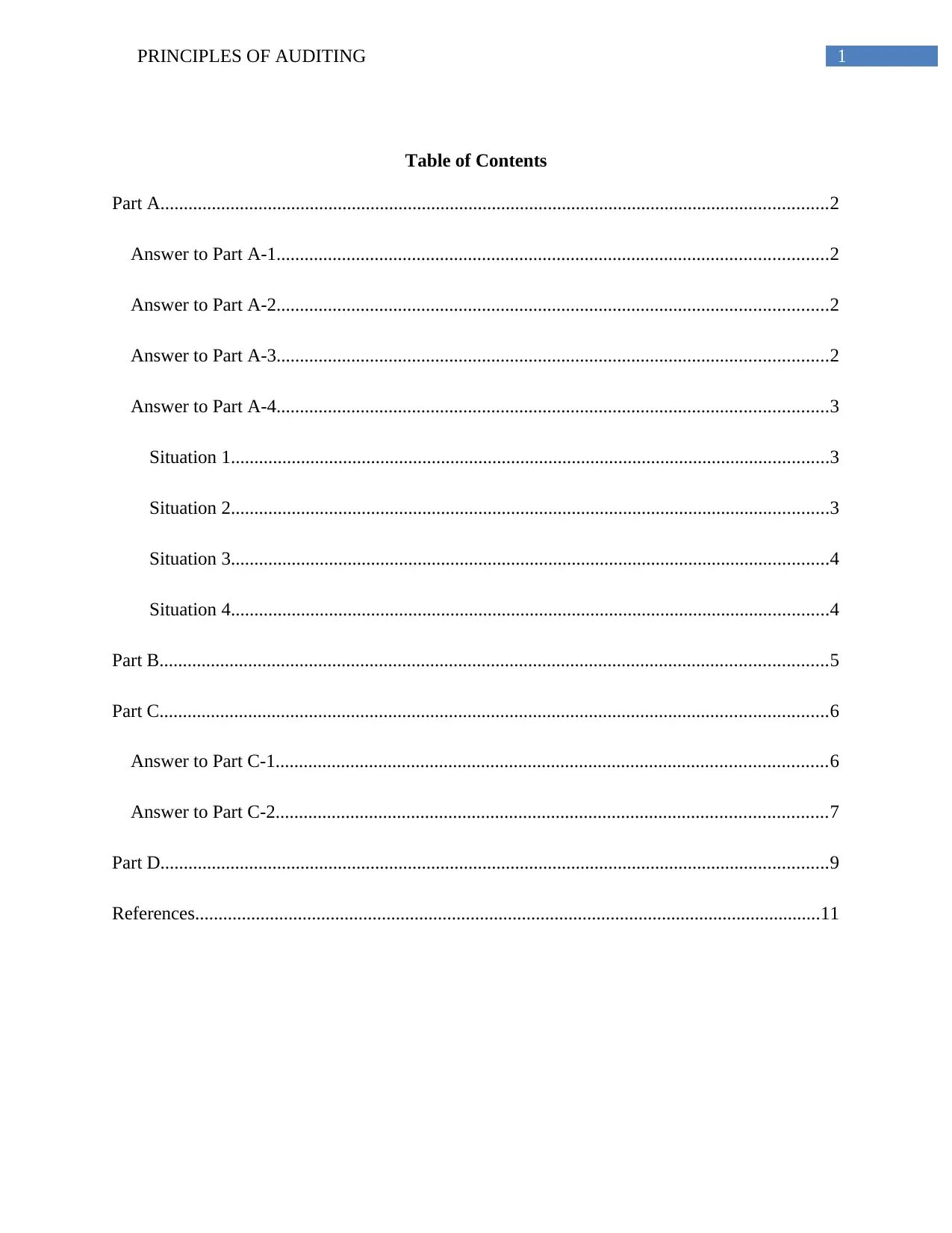
1PRINCIPLES OF AUDITING
Table of Contents
Part A...............................................................................................................................................2
Answer to Part A-1......................................................................................................................2
Answer to Part A-2......................................................................................................................2
Answer to Part A-3......................................................................................................................2
Answer to Part A-4......................................................................................................................3
Situation 1................................................................................................................................3
Situation 2................................................................................................................................3
Situation 3................................................................................................................................4
Situation 4................................................................................................................................4
Part B...............................................................................................................................................5
Part C...............................................................................................................................................6
Answer to Part C-1......................................................................................................................6
Answer to Part C-2......................................................................................................................7
Part D...............................................................................................................................................9
References......................................................................................................................................11
Table of Contents
Part A...............................................................................................................................................2
Answer to Part A-1......................................................................................................................2
Answer to Part A-2......................................................................................................................2
Answer to Part A-3......................................................................................................................2
Answer to Part A-4......................................................................................................................3
Situation 1................................................................................................................................3
Situation 2................................................................................................................................3
Situation 3................................................................................................................................4
Situation 4................................................................................................................................4
Part B...............................................................................................................................................5
Part C...............................................................................................................................................6
Answer to Part C-1......................................................................................................................6
Answer to Part C-2......................................................................................................................7
Part D...............................................................................................................................................9
References......................................................................................................................................11
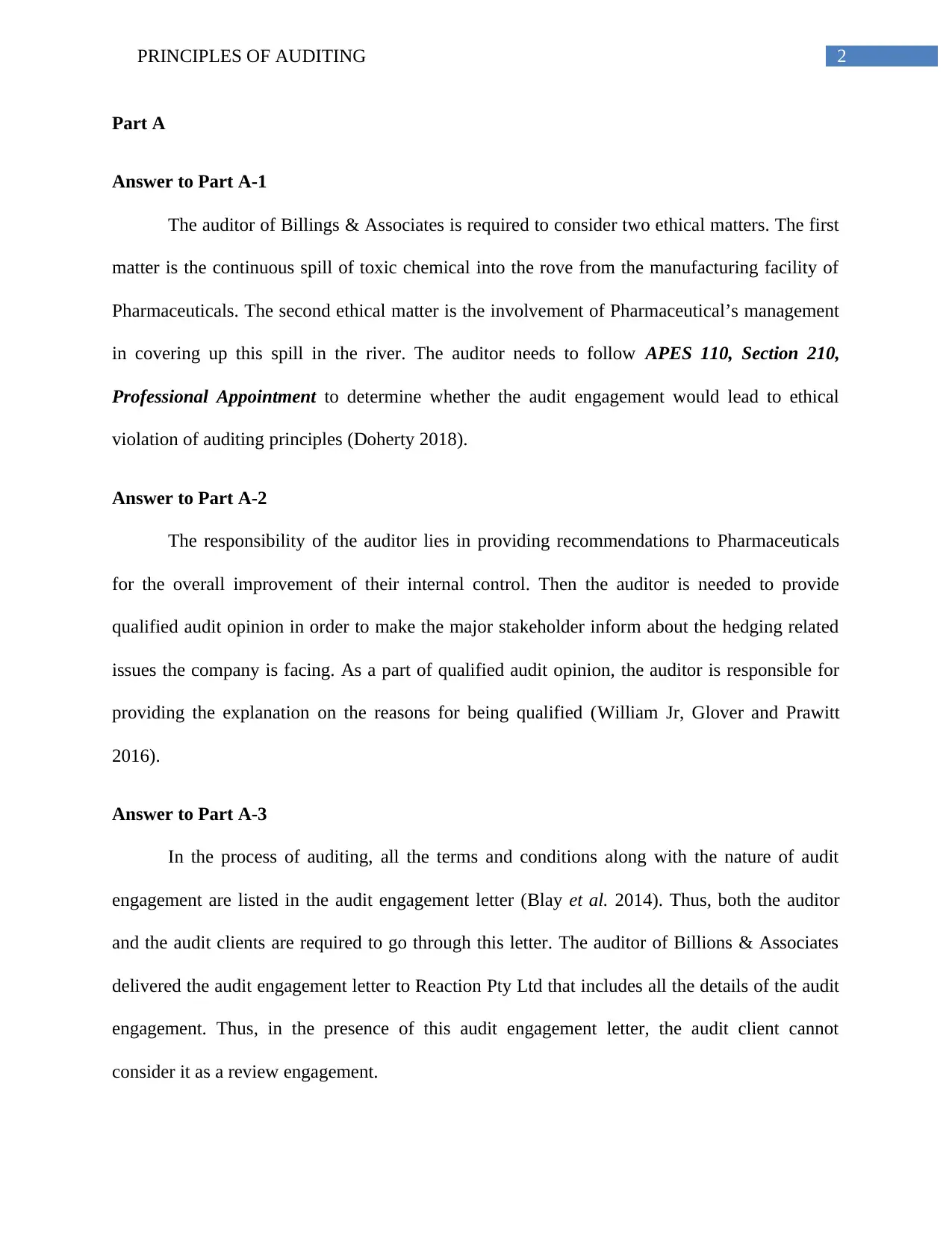
2PRINCIPLES OF AUDITING
Part A
Answer to Part A-1
The auditor of Billings & Associates is required to consider two ethical matters. The first
matter is the continuous spill of toxic chemical into the rove from the manufacturing facility of
Pharmaceuticals. The second ethical matter is the involvement of Pharmaceutical’s management
in covering up this spill in the river. The auditor needs to follow APES 110, Section 210,
Professional Appointment to determine whether the audit engagement would lead to ethical
violation of auditing principles (Doherty 2018).
Answer to Part A-2
The responsibility of the auditor lies in providing recommendations to Pharmaceuticals
for the overall improvement of their internal control. Then the auditor is needed to provide
qualified audit opinion in order to make the major stakeholder inform about the hedging related
issues the company is facing. As a part of qualified audit opinion, the auditor is responsible for
providing the explanation on the reasons for being qualified (William Jr, Glover and Prawitt
2016).
Answer to Part A-3
In the process of auditing, all the terms and conditions along with the nature of audit
engagement are listed in the audit engagement letter (Blay et al. 2014). Thus, both the auditor
and the audit clients are required to go through this letter. The auditor of Billions & Associates
delivered the audit engagement letter to Reaction Pty Ltd that includes all the details of the audit
engagement. Thus, in the presence of this audit engagement letter, the audit client cannot
consider it as a review engagement.
Part A
Answer to Part A-1
The auditor of Billings & Associates is required to consider two ethical matters. The first
matter is the continuous spill of toxic chemical into the rove from the manufacturing facility of
Pharmaceuticals. The second ethical matter is the involvement of Pharmaceutical’s management
in covering up this spill in the river. The auditor needs to follow APES 110, Section 210,
Professional Appointment to determine whether the audit engagement would lead to ethical
violation of auditing principles (Doherty 2018).
Answer to Part A-2
The responsibility of the auditor lies in providing recommendations to Pharmaceuticals
for the overall improvement of their internal control. Then the auditor is needed to provide
qualified audit opinion in order to make the major stakeholder inform about the hedging related
issues the company is facing. As a part of qualified audit opinion, the auditor is responsible for
providing the explanation on the reasons for being qualified (William Jr, Glover and Prawitt
2016).
Answer to Part A-3
In the process of auditing, all the terms and conditions along with the nature of audit
engagement are listed in the audit engagement letter (Blay et al. 2014). Thus, both the auditor
and the audit clients are required to go through this letter. The auditor of Billions & Associates
delivered the audit engagement letter to Reaction Pty Ltd that includes all the details of the audit
engagement. Thus, in the presence of this audit engagement letter, the audit client cannot
consider it as a review engagement.
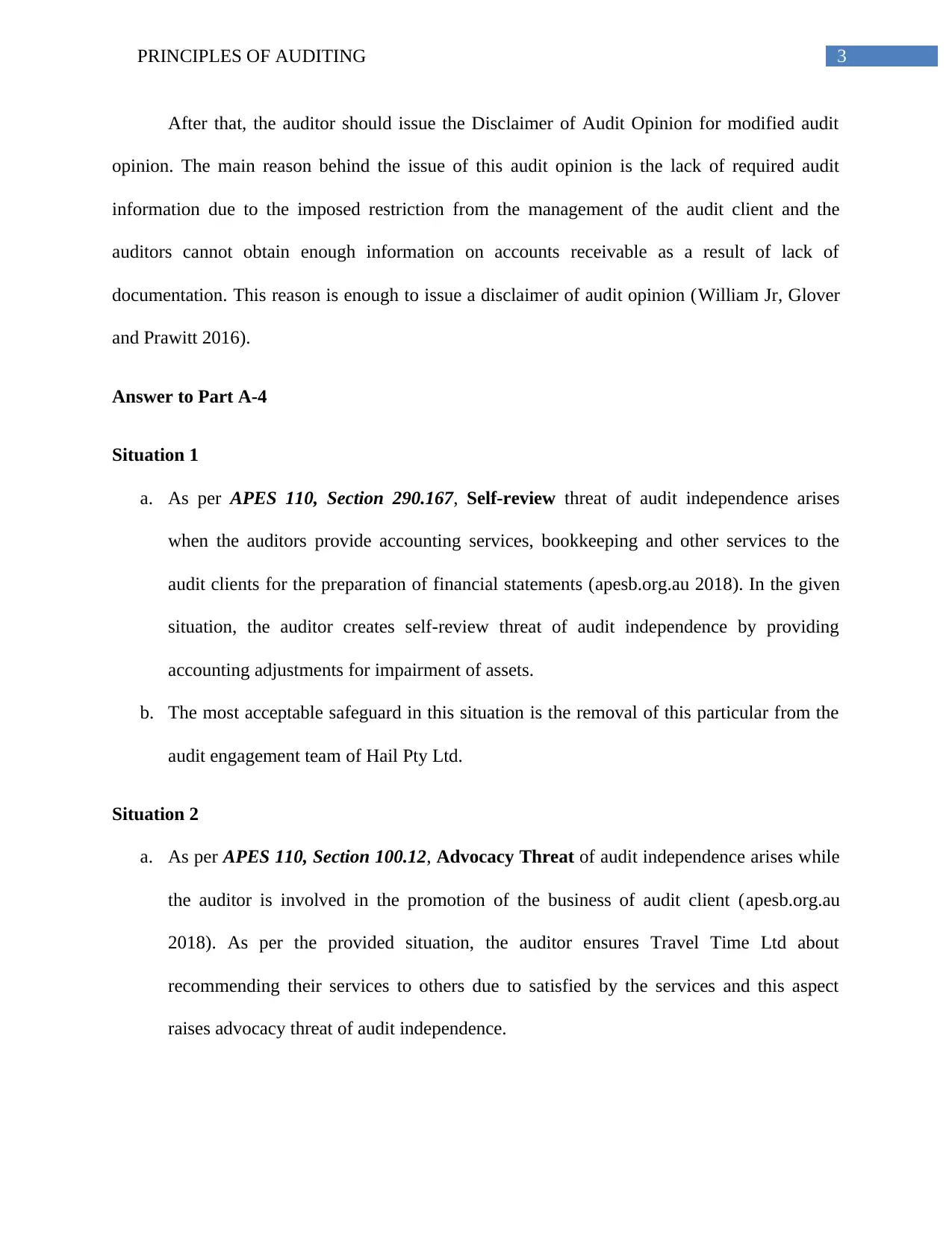
3PRINCIPLES OF AUDITING
After that, the auditor should issue the Disclaimer of Audit Opinion for modified audit
opinion. The main reason behind the issue of this audit opinion is the lack of required audit
information due to the imposed restriction from the management of the audit client and the
auditors cannot obtain enough information on accounts receivable as a result of lack of
documentation. This reason is enough to issue a disclaimer of audit opinion (William Jr, Glover
and Prawitt 2016).
Answer to Part A-4
Situation 1
a. As per APES 110, Section 290.167, Self-review threat of audit independence arises
when the auditors provide accounting services, bookkeeping and other services to the
audit clients for the preparation of financial statements (apesb.org.au 2018). In the given
situation, the auditor creates self-review threat of audit independence by providing
accounting adjustments for impairment of assets.
b. The most acceptable safeguard in this situation is the removal of this particular from the
audit engagement team of Hail Pty Ltd.
Situation 2
a. As per APES 110, Section 100.12, Advocacy Threat of audit independence arises while
the auditor is involved in the promotion of the business of audit client (apesb.org.au
2018). As per the provided situation, the auditor ensures Travel Time Ltd about
recommending their services to others due to satisfied by the services and this aspect
raises advocacy threat of audit independence.
After that, the auditor should issue the Disclaimer of Audit Opinion for modified audit
opinion. The main reason behind the issue of this audit opinion is the lack of required audit
information due to the imposed restriction from the management of the audit client and the
auditors cannot obtain enough information on accounts receivable as a result of lack of
documentation. This reason is enough to issue a disclaimer of audit opinion (William Jr, Glover
and Prawitt 2016).
Answer to Part A-4
Situation 1
a. As per APES 110, Section 290.167, Self-review threat of audit independence arises
when the auditors provide accounting services, bookkeeping and other services to the
audit clients for the preparation of financial statements (apesb.org.au 2018). In the given
situation, the auditor creates self-review threat of audit independence by providing
accounting adjustments for impairment of assets.
b. The most acceptable safeguard in this situation is the removal of this particular from the
audit engagement team of Hail Pty Ltd.
Situation 2
a. As per APES 110, Section 100.12, Advocacy Threat of audit independence arises while
the auditor is involved in the promotion of the business of audit client (apesb.org.au
2018). As per the provided situation, the auditor ensures Travel Time Ltd about
recommending their services to others due to satisfied by the services and this aspect
raises advocacy threat of audit independence.
Secure Best Marks with AI Grader
Need help grading? Try our AI Grader for instant feedback on your assignments.
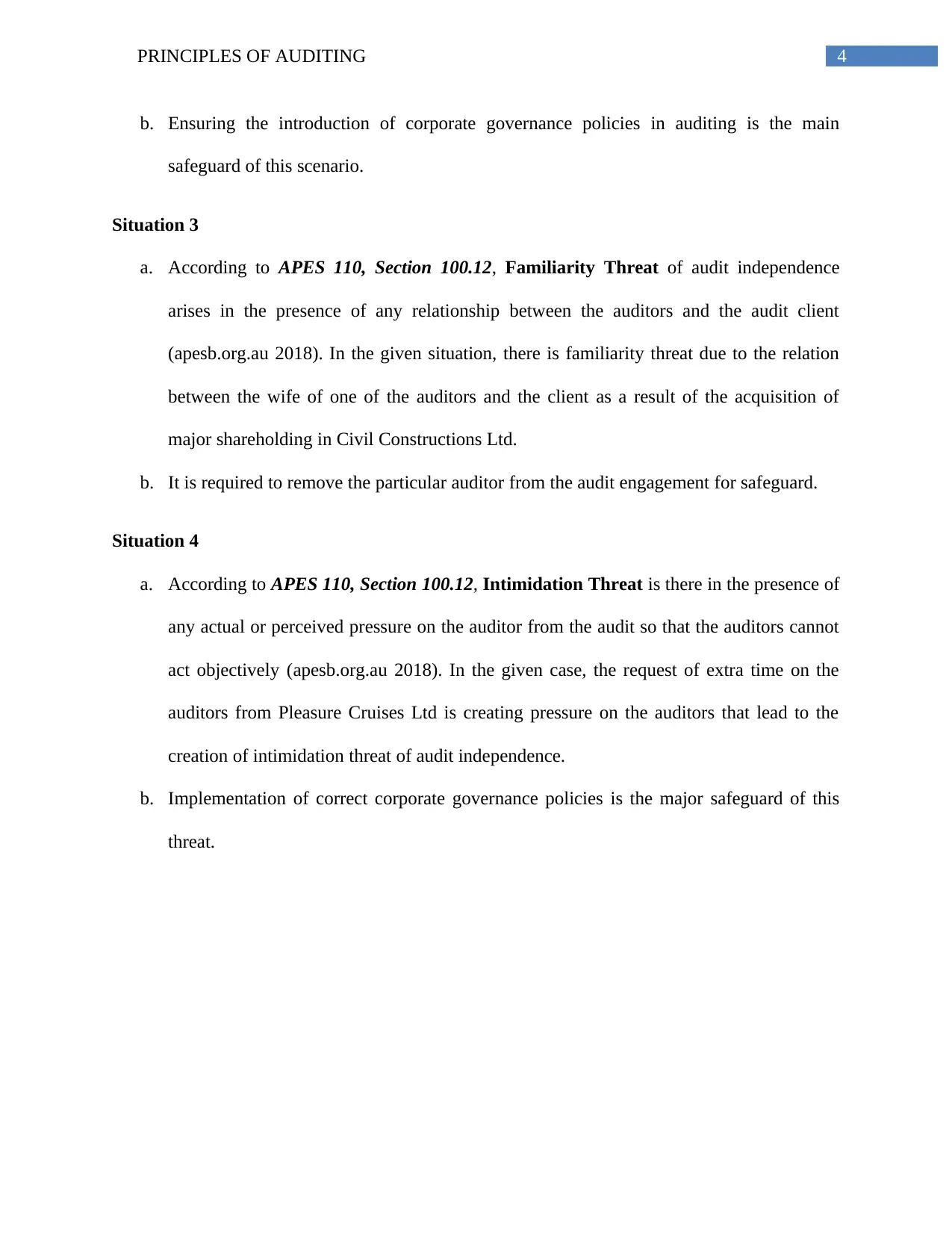
4PRINCIPLES OF AUDITING
b. Ensuring the introduction of corporate governance policies in auditing is the main
safeguard of this scenario.
Situation 3
a. According to APES 110, Section 100.12, Familiarity Threat of audit independence
arises in the presence of any relationship between the auditors and the audit client
(apesb.org.au 2018). In the given situation, there is familiarity threat due to the relation
between the wife of one of the auditors and the client as a result of the acquisition of
major shareholding in Civil Constructions Ltd.
b. It is required to remove the particular auditor from the audit engagement for safeguard.
Situation 4
a. According to APES 110, Section 100.12, Intimidation Threat is there in the presence of
any actual or perceived pressure on the auditor from the audit so that the auditors cannot
act objectively (apesb.org.au 2018). In the given case, the request of extra time on the
auditors from Pleasure Cruises Ltd is creating pressure on the auditors that lead to the
creation of intimidation threat of audit independence.
b. Implementation of correct corporate governance policies is the major safeguard of this
threat.
b. Ensuring the introduction of corporate governance policies in auditing is the main
safeguard of this scenario.
Situation 3
a. According to APES 110, Section 100.12, Familiarity Threat of audit independence
arises in the presence of any relationship between the auditors and the audit client
(apesb.org.au 2018). In the given situation, there is familiarity threat due to the relation
between the wife of one of the auditors and the client as a result of the acquisition of
major shareholding in Civil Constructions Ltd.
b. It is required to remove the particular auditor from the audit engagement for safeguard.
Situation 4
a. According to APES 110, Section 100.12, Intimidation Threat is there in the presence of
any actual or perceived pressure on the auditor from the audit so that the auditors cannot
act objectively (apesb.org.au 2018). In the given case, the request of extra time on the
auditors from Pleasure Cruises Ltd is creating pressure on the auditors that lead to the
creation of intimidation threat of audit independence.
b. Implementation of correct corporate governance policies is the major safeguard of this
threat.
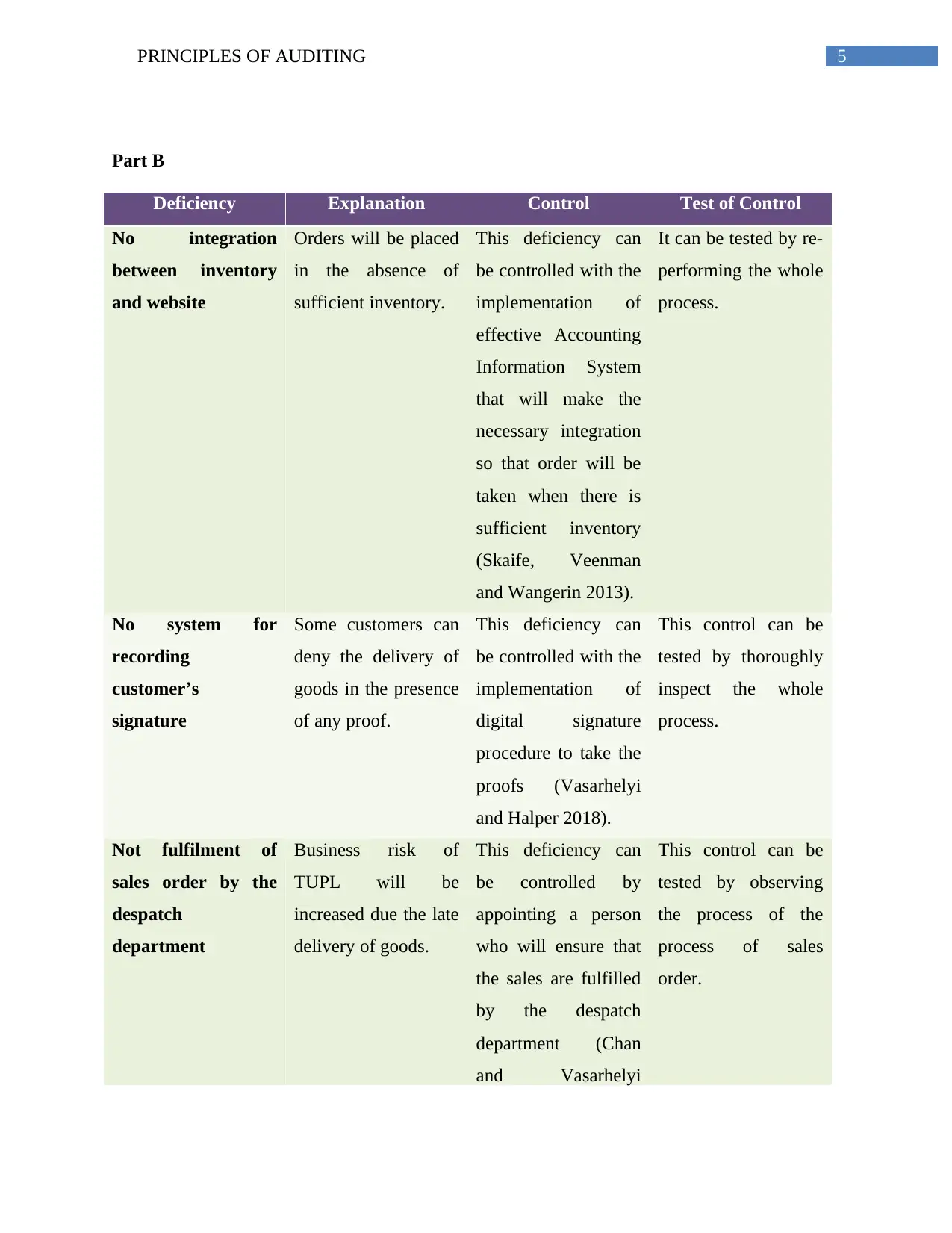
5PRINCIPLES OF AUDITING
Part B
Deficiency Explanation Control Test of Control
No integration
between inventory
and website
Orders will be placed
in the absence of
sufficient inventory.
This deficiency can
be controlled with the
implementation of
effective Accounting
Information System
that will make the
necessary integration
so that order will be
taken when there is
sufficient inventory
(Skaife, Veenman
and Wangerin 2013).
It can be tested by re-
performing the whole
process.
No system for
recording
customer’s
signature
Some customers can
deny the delivery of
goods in the presence
of any proof.
This deficiency can
be controlled with the
implementation of
digital signature
procedure to take the
proofs (Vasarhelyi
and Halper 2018).
This control can be
tested by thoroughly
inspect the whole
process.
Not fulfilment of
sales order by the
despatch
department
Business risk of
TUPL will be
increased due the late
delivery of goods.
This deficiency can
be controlled by
appointing a person
who will ensure that
the sales are fulfilled
by the despatch
department (Chan
and Vasarhelyi
This control can be
tested by observing
the process of the
process of sales
order.
Part B
Deficiency Explanation Control Test of Control
No integration
between inventory
and website
Orders will be placed
in the absence of
sufficient inventory.
This deficiency can
be controlled with the
implementation of
effective Accounting
Information System
that will make the
necessary integration
so that order will be
taken when there is
sufficient inventory
(Skaife, Veenman
and Wangerin 2013).
It can be tested by re-
performing the whole
process.
No system for
recording
customer’s
signature
Some customers can
deny the delivery of
goods in the presence
of any proof.
This deficiency can
be controlled with the
implementation of
digital signature
procedure to take the
proofs (Vasarhelyi
and Halper 2018).
This control can be
tested by thoroughly
inspect the whole
process.
Not fulfilment of
sales order by the
despatch
department
Business risk of
TUPL will be
increased due the late
delivery of goods.
This deficiency can
be controlled by
appointing a person
who will ensure that
the sales are fulfilled
by the despatch
department (Chan
and Vasarhelyi
This control can be
tested by observing
the process of the
process of sales
order.
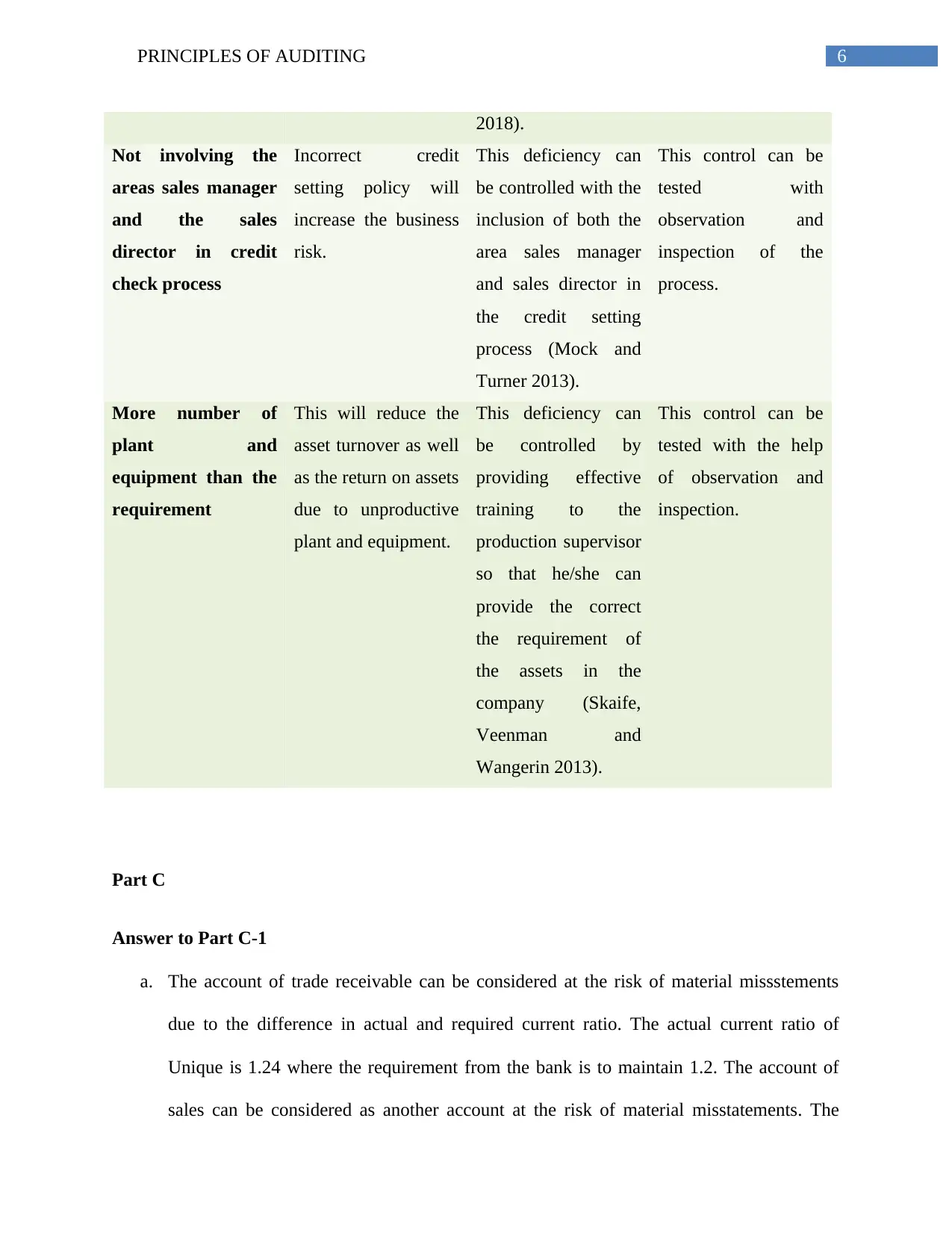
6PRINCIPLES OF AUDITING
2018).
Not involving the
areas sales manager
and the sales
director in credit
check process
Incorrect credit
setting policy will
increase the business
risk.
This deficiency can
be controlled with the
inclusion of both the
area sales manager
and sales director in
the credit setting
process (Mock and
Turner 2013).
This control can be
tested with
observation and
inspection of the
process.
More number of
plant and
equipment than the
requirement
This will reduce the
asset turnover as well
as the return on assets
due to unproductive
plant and equipment.
This deficiency can
be controlled by
providing effective
training to the
production supervisor
so that he/she can
provide the correct
the requirement of
the assets in the
company (Skaife,
Veenman and
Wangerin 2013).
This control can be
tested with the help
of observation and
inspection.
Part C
Answer to Part C-1
a. The account of trade receivable can be considered at the risk of material missstements
due to the difference in actual and required current ratio. The actual current ratio of
Unique is 1.24 where the requirement from the bank is to maintain 1.2. The account of
sales can be considered as another account at the risk of material misstatements. The
2018).
Not involving the
areas sales manager
and the sales
director in credit
check process
Incorrect credit
setting policy will
increase the business
risk.
This deficiency can
be controlled with the
inclusion of both the
area sales manager
and sales director in
the credit setting
process (Mock and
Turner 2013).
This control can be
tested with
observation and
inspection of the
process.
More number of
plant and
equipment than the
requirement
This will reduce the
asset turnover as well
as the return on assets
due to unproductive
plant and equipment.
This deficiency can
be controlled by
providing effective
training to the
production supervisor
so that he/she can
provide the correct
the requirement of
the assets in the
company (Skaife,
Veenman and
Wangerin 2013).
This control can be
tested with the help
of observation and
inspection.
Part C
Answer to Part C-1
a. The account of trade receivable can be considered at the risk of material missstements
due to the difference in actual and required current ratio. The actual current ratio of
Unique is 1.24 where the requirement from the bank is to maintain 1.2. The account of
sales can be considered as another account at the risk of material misstatements. The
Paraphrase This Document
Need a fresh take? Get an instant paraphrase of this document with our AI Paraphraser
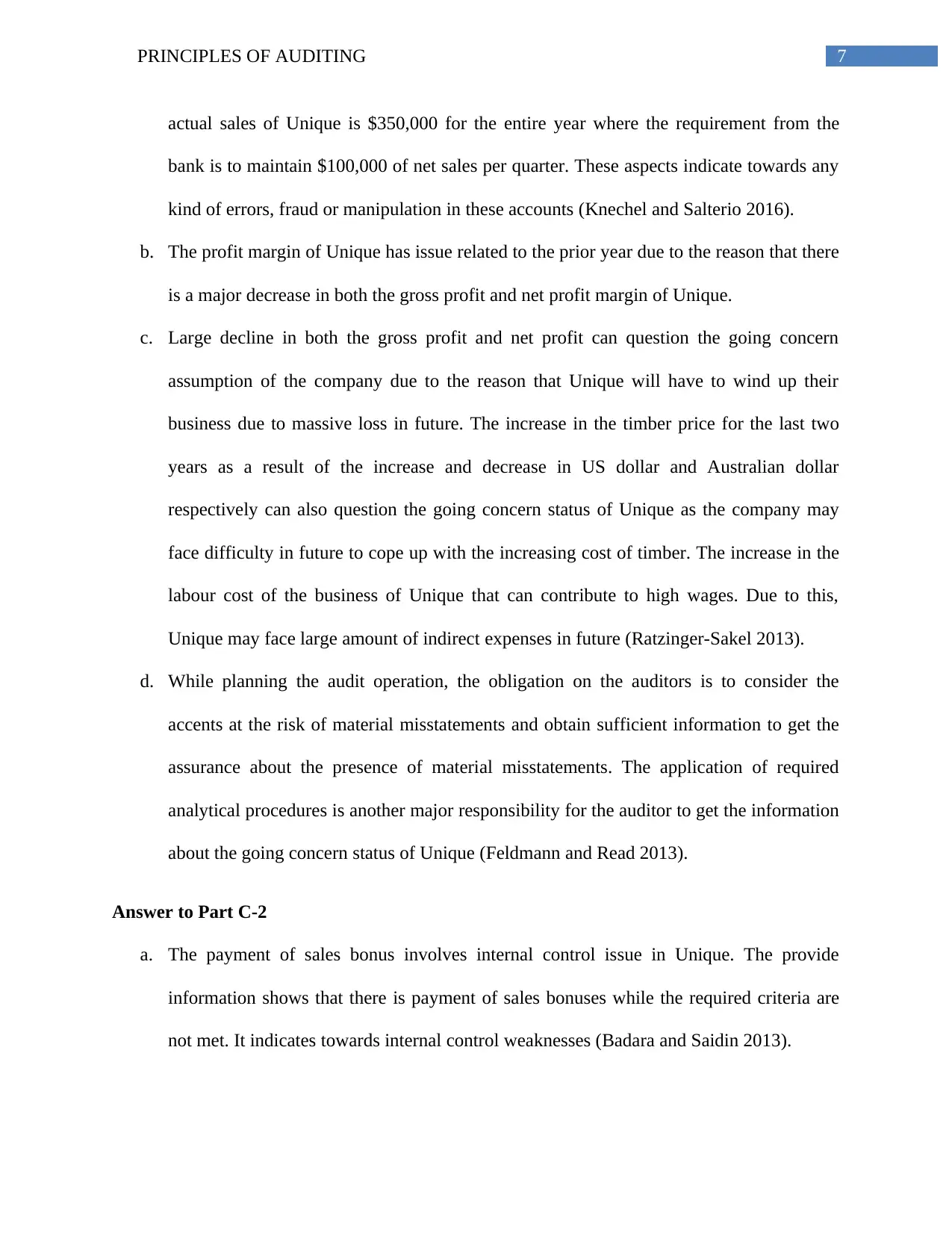
7PRINCIPLES OF AUDITING
actual sales of Unique is $350,000 for the entire year where the requirement from the
bank is to maintain $100,000 of net sales per quarter. These aspects indicate towards any
kind of errors, fraud or manipulation in these accounts (Knechel and Salterio 2016).
b. The profit margin of Unique has issue related to the prior year due to the reason that there
is a major decrease in both the gross profit and net profit margin of Unique.
c. Large decline in both the gross profit and net profit can question the going concern
assumption of the company due to the reason that Unique will have to wind up their
business due to massive loss in future. The increase in the timber price for the last two
years as a result of the increase and decrease in US dollar and Australian dollar
respectively can also question the going concern status of Unique as the company may
face difficulty in future to cope up with the increasing cost of timber. The increase in the
labour cost of the business of Unique that can contribute to high wages. Due to this,
Unique may face large amount of indirect expenses in future (Ratzinger-Sakel 2013).
d. While planning the audit operation, the obligation on the auditors is to consider the
accents at the risk of material misstatements and obtain sufficient information to get the
assurance about the presence of material misstatements. The application of required
analytical procedures is another major responsibility for the auditor to get the information
about the going concern status of Unique (Feldmann and Read 2013).
Answer to Part C-2
a. The payment of sales bonus involves internal control issue in Unique. The provide
information shows that there is payment of sales bonuses while the required criteria are
not met. It indicates towards internal control weaknesses (Badara and Saidin 2013).
actual sales of Unique is $350,000 for the entire year where the requirement from the
bank is to maintain $100,000 of net sales per quarter. These aspects indicate towards any
kind of errors, fraud or manipulation in these accounts (Knechel and Salterio 2016).
b. The profit margin of Unique has issue related to the prior year due to the reason that there
is a major decrease in both the gross profit and net profit margin of Unique.
c. Large decline in both the gross profit and net profit can question the going concern
assumption of the company due to the reason that Unique will have to wind up their
business due to massive loss in future. The increase in the timber price for the last two
years as a result of the increase and decrease in US dollar and Australian dollar
respectively can also question the going concern status of Unique as the company may
face difficulty in future to cope up with the increasing cost of timber. The increase in the
labour cost of the business of Unique that can contribute to high wages. Due to this,
Unique may face large amount of indirect expenses in future (Ratzinger-Sakel 2013).
d. While planning the audit operation, the obligation on the auditors is to consider the
accents at the risk of material misstatements and obtain sufficient information to get the
assurance about the presence of material misstatements. The application of required
analytical procedures is another major responsibility for the auditor to get the information
about the going concern status of Unique (Feldmann and Read 2013).
Answer to Part C-2
a. The payment of sales bonus involves internal control issue in Unique. The provide
information shows that there is payment of sales bonuses while the required criteria are
not met. It indicates towards internal control weaknesses (Badara and Saidin 2013).
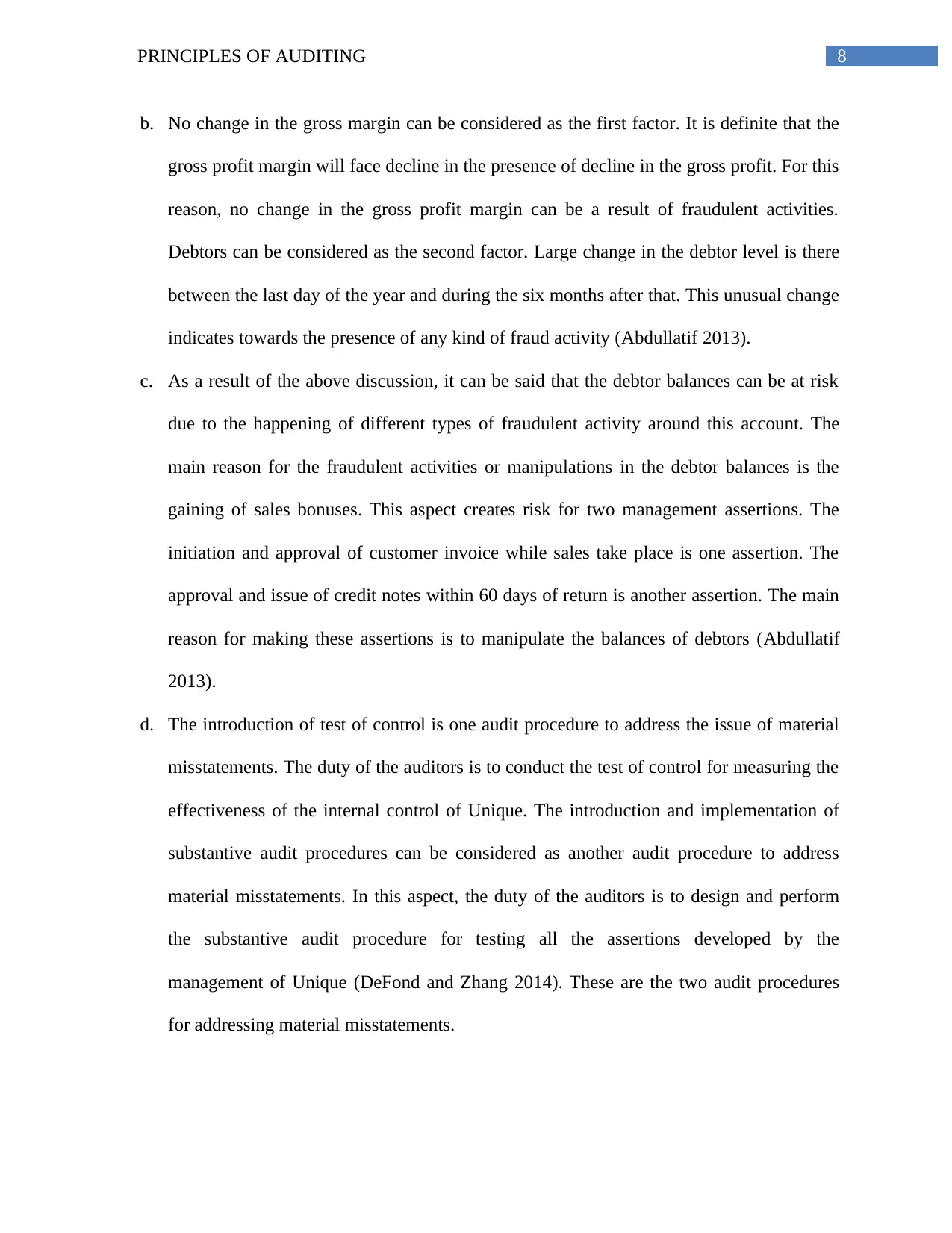
8PRINCIPLES OF AUDITING
b. No change in the gross margin can be considered as the first factor. It is definite that the
gross profit margin will face decline in the presence of decline in the gross profit. For this
reason, no change in the gross profit margin can be a result of fraudulent activities.
Debtors can be considered as the second factor. Large change in the debtor level is there
between the last day of the year and during the six months after that. This unusual change
indicates towards the presence of any kind of fraud activity (Abdullatif 2013).
c. As a result of the above discussion, it can be said that the debtor balances can be at risk
due to the happening of different types of fraudulent activity around this account. The
main reason for the fraudulent activities or manipulations in the debtor balances is the
gaining of sales bonuses. This aspect creates risk for two management assertions. The
initiation and approval of customer invoice while sales take place is one assertion. The
approval and issue of credit notes within 60 days of return is another assertion. The main
reason for making these assertions is to manipulate the balances of debtors (Abdullatif
2013).
d. The introduction of test of control is one audit procedure to address the issue of material
misstatements. The duty of the auditors is to conduct the test of control for measuring the
effectiveness of the internal control of Unique. The introduction and implementation of
substantive audit procedures can be considered as another audit procedure to address
material misstatements. In this aspect, the duty of the auditors is to design and perform
the substantive audit procedure for testing all the assertions developed by the
management of Unique (DeFond and Zhang 2014). These are the two audit procedures
for addressing material misstatements.
b. No change in the gross margin can be considered as the first factor. It is definite that the
gross profit margin will face decline in the presence of decline in the gross profit. For this
reason, no change in the gross profit margin can be a result of fraudulent activities.
Debtors can be considered as the second factor. Large change in the debtor level is there
between the last day of the year and during the six months after that. This unusual change
indicates towards the presence of any kind of fraud activity (Abdullatif 2013).
c. As a result of the above discussion, it can be said that the debtor balances can be at risk
due to the happening of different types of fraudulent activity around this account. The
main reason for the fraudulent activities or manipulations in the debtor balances is the
gaining of sales bonuses. This aspect creates risk for two management assertions. The
initiation and approval of customer invoice while sales take place is one assertion. The
approval and issue of credit notes within 60 days of return is another assertion. The main
reason for making these assertions is to manipulate the balances of debtors (Abdullatif
2013).
d. The introduction of test of control is one audit procedure to address the issue of material
misstatements. The duty of the auditors is to conduct the test of control for measuring the
effectiveness of the internal control of Unique. The introduction and implementation of
substantive audit procedures can be considered as another audit procedure to address
material misstatements. In this aspect, the duty of the auditors is to design and perform
the substantive audit procedure for testing all the assertions developed by the
management of Unique (DeFond and Zhang 2014). These are the two audit procedures
for addressing material misstatements.
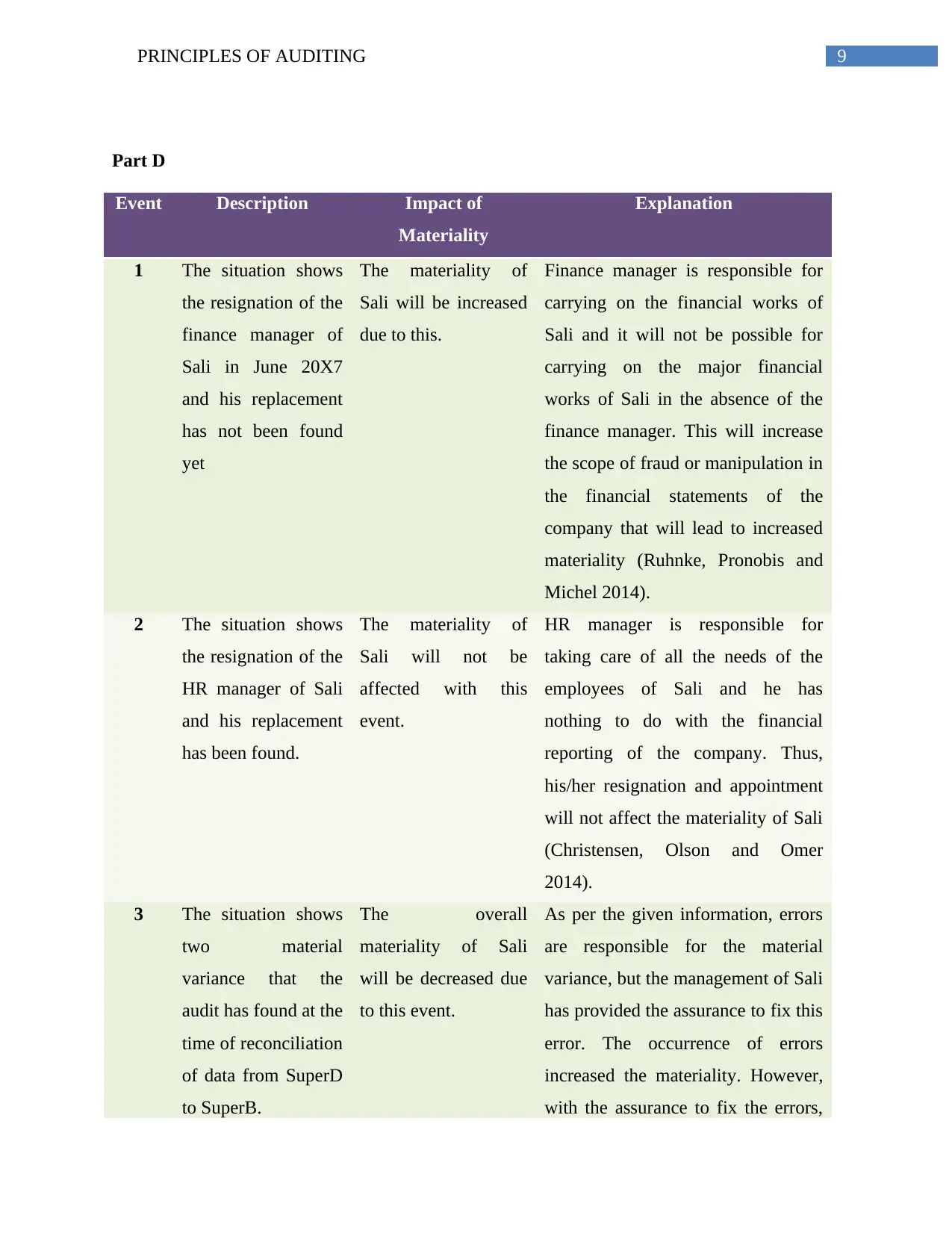
9PRINCIPLES OF AUDITING
Part D
Event Description Impact of
Materiality
Explanation
1 The situation shows
the resignation of the
finance manager of
Sali in June 20X7
and his replacement
has not been found
yet
The materiality of
Sali will be increased
due to this.
Finance manager is responsible for
carrying on the financial works of
Sali and it will not be possible for
carrying on the major financial
works of Sali in the absence of the
finance manager. This will increase
the scope of fraud or manipulation in
the financial statements of the
company that will lead to increased
materiality (Ruhnke, Pronobis and
Michel 2014).
2 The situation shows
the resignation of the
HR manager of Sali
and his replacement
has been found.
The materiality of
Sali will not be
affected with this
event.
HR manager is responsible for
taking care of all the needs of the
employees of Sali and he has
nothing to do with the financial
reporting of the company. Thus,
his/her resignation and appointment
will not affect the materiality of Sali
(Christensen, Olson and Omer
2014).
3 The situation shows
two material
variance that the
audit has found at the
time of reconciliation
of data from SuperD
to SuperB.
The overall
materiality of Sali
will be decreased due
to this event.
As per the given information, errors
are responsible for the material
variance, but the management of Sali
has provided the assurance to fix this
error. The occurrence of errors
increased the materiality. However,
with the assurance to fix the errors,
Part D
Event Description Impact of
Materiality
Explanation
1 The situation shows
the resignation of the
finance manager of
Sali in June 20X7
and his replacement
has not been found
yet
The materiality of
Sali will be increased
due to this.
Finance manager is responsible for
carrying on the financial works of
Sali and it will not be possible for
carrying on the major financial
works of Sali in the absence of the
finance manager. This will increase
the scope of fraud or manipulation in
the financial statements of the
company that will lead to increased
materiality (Ruhnke, Pronobis and
Michel 2014).
2 The situation shows
the resignation of the
HR manager of Sali
and his replacement
has been found.
The materiality of
Sali will not be
affected with this
event.
HR manager is responsible for
taking care of all the needs of the
employees of Sali and he has
nothing to do with the financial
reporting of the company. Thus,
his/her resignation and appointment
will not affect the materiality of Sali
(Christensen, Olson and Omer
2014).
3 The situation shows
two material
variance that the
audit has found at the
time of reconciliation
of data from SuperD
to SuperB.
The overall
materiality of Sali
will be decreased due
to this event.
As per the given information, errors
are responsible for the material
variance, but the management of Sali
has provided the assurance to fix this
error. The occurrence of errors
increased the materiality. However,
with the assurance to fix the errors,
Secure Best Marks with AI Grader
Need help grading? Try our AI Grader for instant feedback on your assignments.
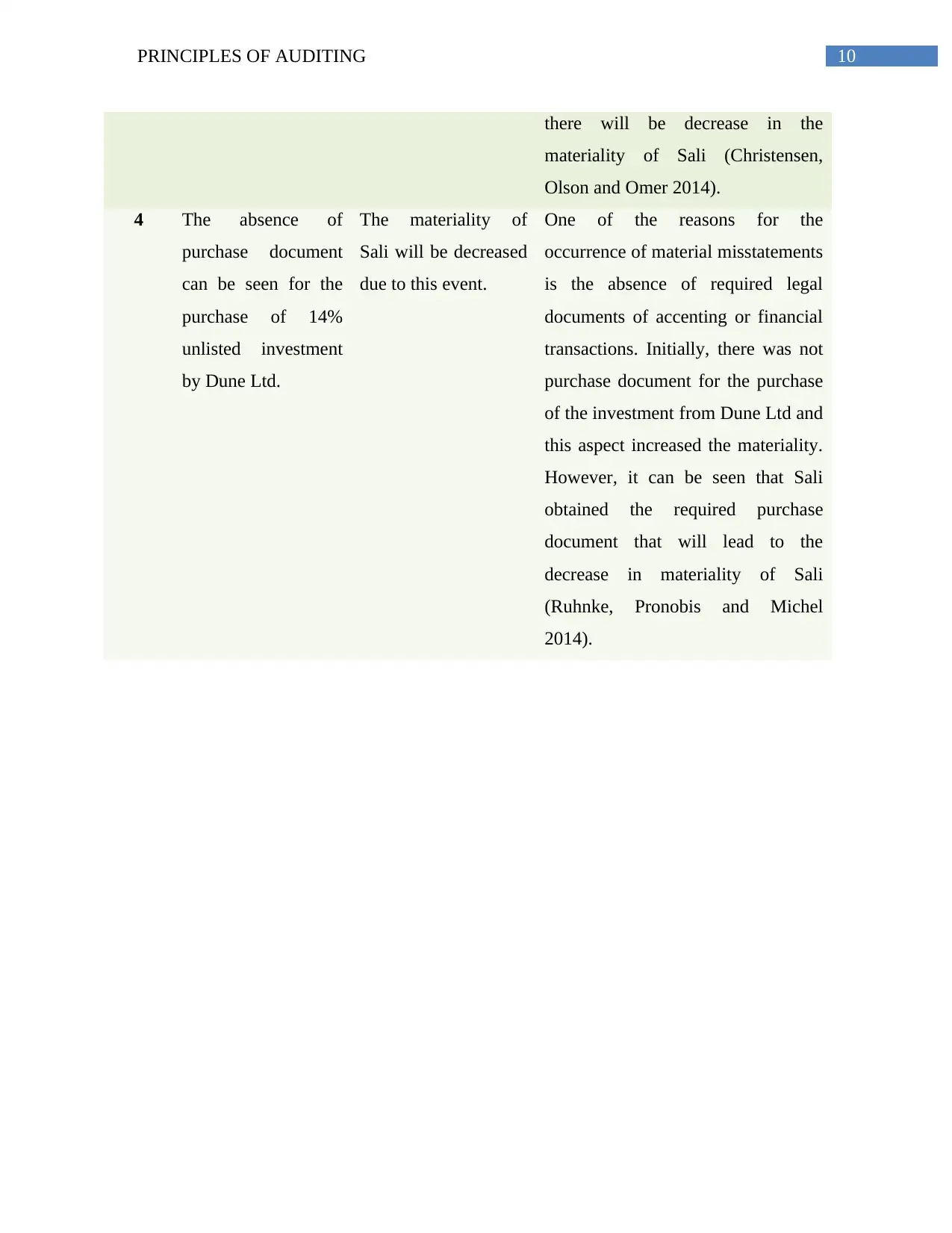
10PRINCIPLES OF AUDITING
there will be decrease in the
materiality of Sali (Christensen,
Olson and Omer 2014).
4 The absence of
purchase document
can be seen for the
purchase of 14%
unlisted investment
by Dune Ltd.
The materiality of
Sali will be decreased
due to this event.
One of the reasons for the
occurrence of material misstatements
is the absence of required legal
documents of accenting or financial
transactions. Initially, there was not
purchase document for the purchase
of the investment from Dune Ltd and
this aspect increased the materiality.
However, it can be seen that Sali
obtained the required purchase
document that will lead to the
decrease in materiality of Sali
(Ruhnke, Pronobis and Michel
2014).
there will be decrease in the
materiality of Sali (Christensen,
Olson and Omer 2014).
4 The absence of
purchase document
can be seen for the
purchase of 14%
unlisted investment
by Dune Ltd.
The materiality of
Sali will be decreased
due to this event.
One of the reasons for the
occurrence of material misstatements
is the absence of required legal
documents of accenting or financial
transactions. Initially, there was not
purchase document for the purchase
of the investment from Dune Ltd and
this aspect increased the materiality.
However, it can be seen that Sali
obtained the required purchase
document that will lead to the
decrease in materiality of Sali
(Ruhnke, Pronobis and Michel
2014).
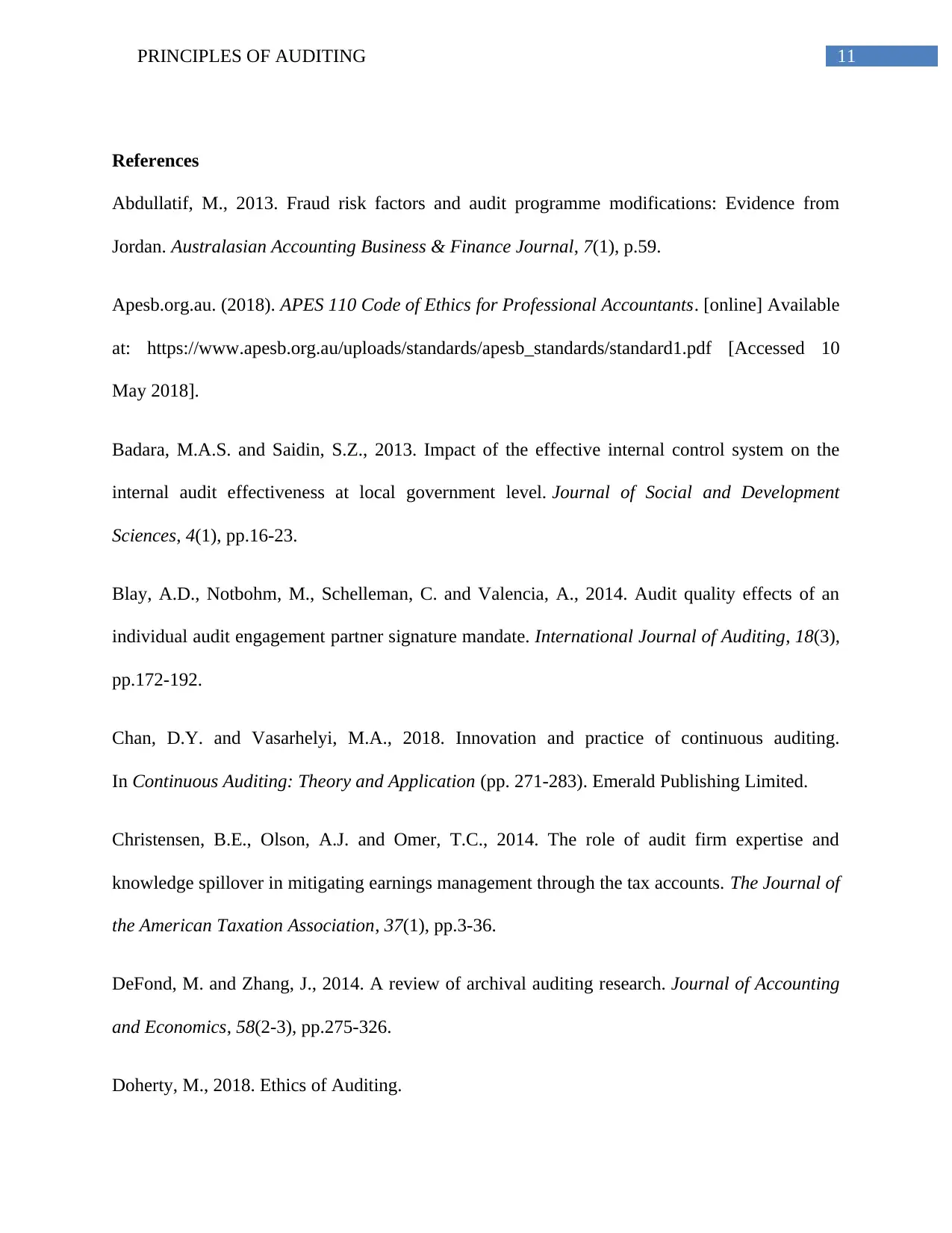
11PRINCIPLES OF AUDITING
References
Abdullatif, M., 2013. Fraud risk factors and audit programme modifications: Evidence from
Jordan. Australasian Accounting Business & Finance Journal, 7(1), p.59.
Apesb.org.au. (2018). APES 110 Code of Ethics for Professional Accountants. [online] Available
at: https://www.apesb.org.au/uploads/standards/apesb_standards/standard1.pdf [Accessed 10
May 2018].
Badara, M.A.S. and Saidin, S.Z., 2013. Impact of the effective internal control system on the
internal audit effectiveness at local government level. Journal of Social and Development
Sciences, 4(1), pp.16-23.
Blay, A.D., Notbohm, M., Schelleman, C. and Valencia, A., 2014. Audit quality effects of an
individual audit engagement partner signature mandate. International Journal of Auditing, 18(3),
pp.172-192.
Chan, D.Y. and Vasarhelyi, M.A., 2018. Innovation and practice of continuous auditing.
In Continuous Auditing: Theory and Application (pp. 271-283). Emerald Publishing Limited.
Christensen, B.E., Olson, A.J. and Omer, T.C., 2014. The role of audit firm expertise and
knowledge spillover in mitigating earnings management through the tax accounts. The Journal of
the American Taxation Association, 37(1), pp.3-36.
DeFond, M. and Zhang, J., 2014. A review of archival auditing research. Journal of Accounting
and Economics, 58(2-3), pp.275-326.
Doherty, M., 2018. Ethics of Auditing.
References
Abdullatif, M., 2013. Fraud risk factors and audit programme modifications: Evidence from
Jordan. Australasian Accounting Business & Finance Journal, 7(1), p.59.
Apesb.org.au. (2018). APES 110 Code of Ethics for Professional Accountants. [online] Available
at: https://www.apesb.org.au/uploads/standards/apesb_standards/standard1.pdf [Accessed 10
May 2018].
Badara, M.A.S. and Saidin, S.Z., 2013. Impact of the effective internal control system on the
internal audit effectiveness at local government level. Journal of Social and Development
Sciences, 4(1), pp.16-23.
Blay, A.D., Notbohm, M., Schelleman, C. and Valencia, A., 2014. Audit quality effects of an
individual audit engagement partner signature mandate. International Journal of Auditing, 18(3),
pp.172-192.
Chan, D.Y. and Vasarhelyi, M.A., 2018. Innovation and practice of continuous auditing.
In Continuous Auditing: Theory and Application (pp. 271-283). Emerald Publishing Limited.
Christensen, B.E., Olson, A.J. and Omer, T.C., 2014. The role of audit firm expertise and
knowledge spillover in mitigating earnings management through the tax accounts. The Journal of
the American Taxation Association, 37(1), pp.3-36.
DeFond, M. and Zhang, J., 2014. A review of archival auditing research. Journal of Accounting
and Economics, 58(2-3), pp.275-326.
Doherty, M., 2018. Ethics of Auditing.
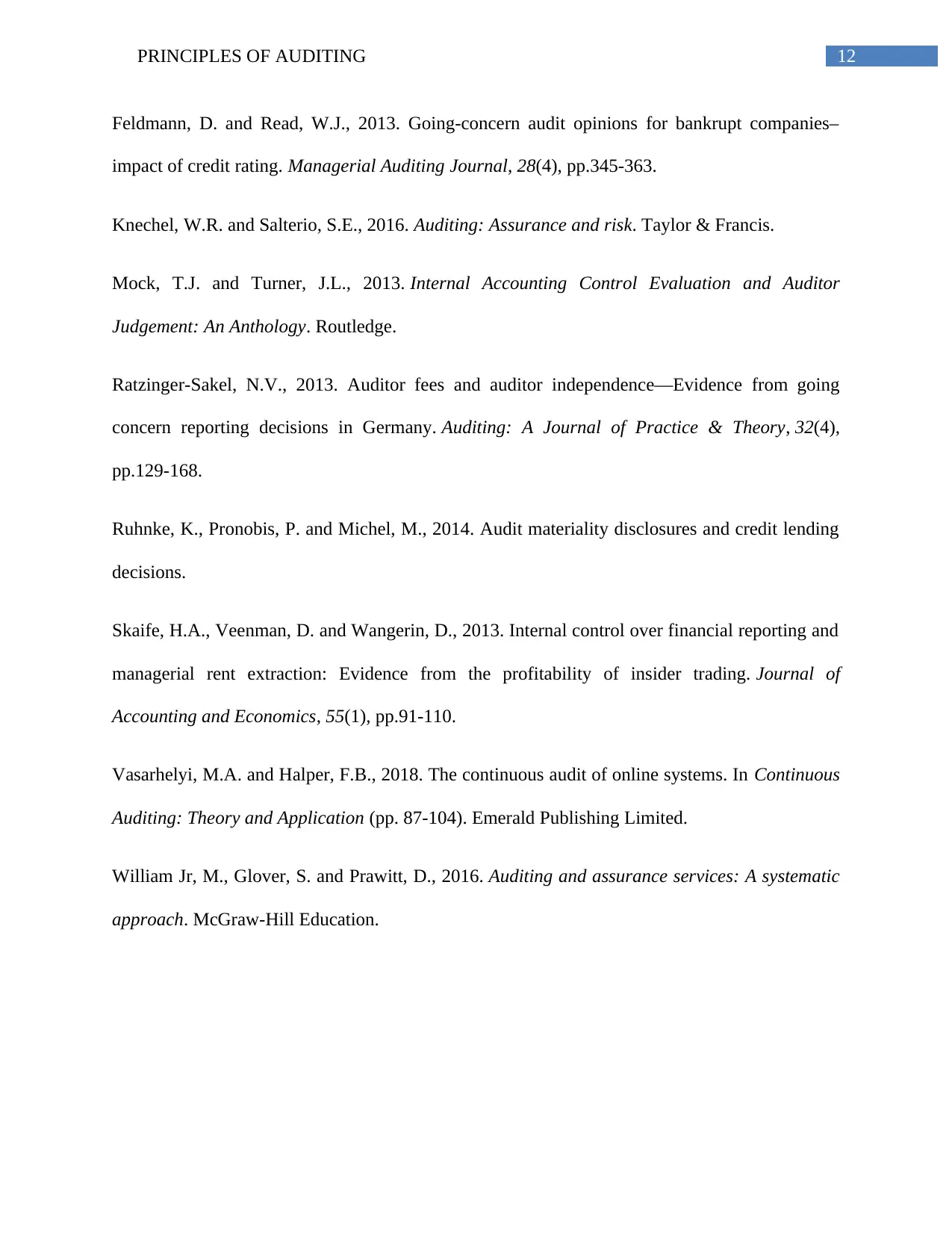
12PRINCIPLES OF AUDITING
Feldmann, D. and Read, W.J., 2013. Going-concern audit opinions for bankrupt companies–
impact of credit rating. Managerial Auditing Journal, 28(4), pp.345-363.
Knechel, W.R. and Salterio, S.E., 2016. Auditing: Assurance and risk. Taylor & Francis.
Mock, T.J. and Turner, J.L., 2013. Internal Accounting Control Evaluation and Auditor
Judgement: An Anthology. Routledge.
Ratzinger-Sakel, N.V., 2013. Auditor fees and auditor independence—Evidence from going
concern reporting decisions in Germany. Auditing: A Journal of Practice & Theory, 32(4),
pp.129-168.
Ruhnke, K., Pronobis, P. and Michel, M., 2014. Audit materiality disclosures and credit lending
decisions.
Skaife, H.A., Veenman, D. and Wangerin, D., 2013. Internal control over financial reporting and
managerial rent extraction: Evidence from the profitability of insider trading. Journal of
Accounting and Economics, 55(1), pp.91-110.
Vasarhelyi, M.A. and Halper, F.B., 2018. The continuous audit of online systems. In Continuous
Auditing: Theory and Application (pp. 87-104). Emerald Publishing Limited.
William Jr, M., Glover, S. and Prawitt, D., 2016. Auditing and assurance services: A systematic
approach. McGraw-Hill Education.
Feldmann, D. and Read, W.J., 2013. Going-concern audit opinions for bankrupt companies–
impact of credit rating. Managerial Auditing Journal, 28(4), pp.345-363.
Knechel, W.R. and Salterio, S.E., 2016. Auditing: Assurance and risk. Taylor & Francis.
Mock, T.J. and Turner, J.L., 2013. Internal Accounting Control Evaluation and Auditor
Judgement: An Anthology. Routledge.
Ratzinger-Sakel, N.V., 2013. Auditor fees and auditor independence—Evidence from going
concern reporting decisions in Germany. Auditing: A Journal of Practice & Theory, 32(4),
pp.129-168.
Ruhnke, K., Pronobis, P. and Michel, M., 2014. Audit materiality disclosures and credit lending
decisions.
Skaife, H.A., Veenman, D. and Wangerin, D., 2013. Internal control over financial reporting and
managerial rent extraction: Evidence from the profitability of insider trading. Journal of
Accounting and Economics, 55(1), pp.91-110.
Vasarhelyi, M.A. and Halper, F.B., 2018. The continuous audit of online systems. In Continuous
Auditing: Theory and Application (pp. 87-104). Emerald Publishing Limited.
William Jr, M., Glover, S. and Prawitt, D., 2016. Auditing and assurance services: A systematic
approach. McGraw-Hill Education.
1 out of 13
Related Documents
Your All-in-One AI-Powered Toolkit for Academic Success.
+13062052269
info@desklib.com
Available 24*7 on WhatsApp / Email
![[object Object]](/_next/static/media/star-bottom.7253800d.svg)
Unlock your academic potential
© 2024 | Zucol Services PVT LTD | All rights reserved.





